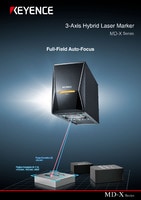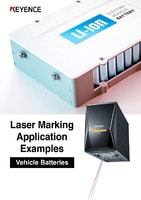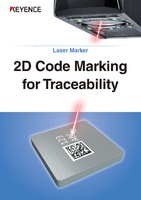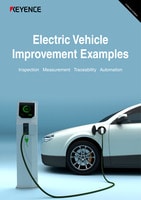Industrial Laser Marking Systems / Laser Markers
Comparison of Different Types of Electric Vehicle Battery Cells
-
Tags:
- Electric Vehicle , Laser Cleaning , Laser Labeling
The push for environmentally friendly and cost-efficient vehicles is increasing as time goes on. Because of this, more people are purchasing electric vehicles (EVs) and car companies are making the switch. In fact, Forbes reported that electric vehicle sales made up 5.6% of 2022 Q2 total auto market sales.
Unlike traditional gas-powered vehicles, electric vehicles operate with a battery. Although electric car batteries have advantages like a lightweight feel and being more environmentally friendly, critics of electric vehicles critique the driving range and recharging abilities of EVs.
Because of this, EV manufacturers are trying to find the best battery for EVs. In the following, we’ll explore the three types of electric car batteries and how they differ in terms of chemical composition, size, capacity, life span, pros, and cons.
The 3 Different Types of Car Batteries
There are three types of EV battery cells for electric vehicles: cylindrical, prismatic, and pouch. All of these batteries are lithium-ion based with some type of casing. Each type of battery has a specific chemical composition, size, capacity, and lifespan that make them more or less desirable for EVs. Understanding the differences show why a manufacturer may prefer one battery over another.
Cylindrical
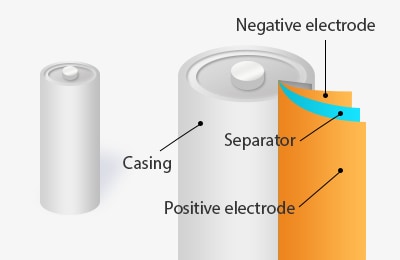
Prismatic
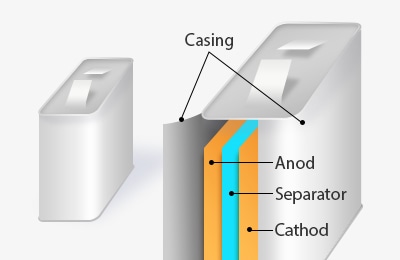
Pouch
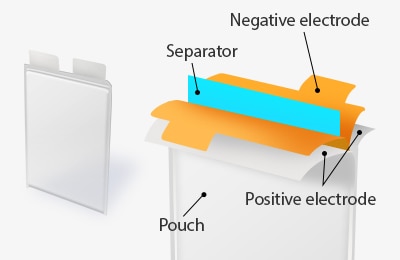
| Cylindrical | Prismatic | Pouch | |
|---|---|---|---|
|
Capacity
|
Cylindrical
2,300 - 26,000 mAh(depending on size)
|
Prismatic
20,000 - 30,000 mAh
|
Pouch
2,300 - 26,000 mAh(depending on size)
|
|
Lifespan
|
Cylindrical
25,000 cycles
|
Prismatic
2,000 cycles
|
Pouch
2,000 cycles
|
|
Size
|
Cylindrical
Medium
|
Prismatic
Large
|
Pouch
Small
|
|
Cost
|
Cylindrical
Low cost
|
Prismatic
Moderate cost
|
Pouch
High cost
|
|
Overheating risk
|
Cylindrical
Low
|
Prismatic
Medium
|
Pouch
High
|
|
Year invented
|
Cylindrical
1880s
|
Prismatic
1960s
|
Pouch
1970s
|
|
Cell gaps
|
Cylindrical
Yes
|
Prismatic
No
|
Pouch
No
|
|
Weight
|
Cylindrical
Heavy
|
Prismatic
Medium
|
Pouch
Light
|
|
Chemical composition
|
Cylindrical
Lithitm -ionAluminum or steel casing
|
Prismatic
Lithitm -ionAluminum or steel casing
|
Pouch
LithiumPolymer-coated aluminium foil
|
|
Popularly used by
|
Cylindrical
Tesla
|
Prismatic
BMW, Volkswagen
|
Pouch
General motors
|
For more details on the differences between cylindrical, prismatic, and pouch battery cells continue with this article.
Contact us to learn more about how our advanced technology can help take your business to the next level.
Contact Us
Cathode and Anode Foil Traceability
Regardless of the battery type, cylindrical, prismatic, or pouch, they are all derived from a cathode and anode structure. One of the first steps in the battery manufacturing process is applying a slurry to these cathode or anode foils. Laser marking can provide much needed traceability in this area, and whether the foils go on to get stacked, folded, or rolled this traceability will stick with it.
Cylindrical
- Chemical Composition
- Cylindrical batteries are the classic version of electric vehicle batteries. These batteries are made up of a lithium-ion battery with an aluminium or steel casing. The cylindrical shape is created by electrodes and separators layered together and then rolled together.
- Size
- A cylindrical battery comes in a variety of sizes for different applications. For electric vehicles, the sizes of cylindrical batteries are 1850, 21700, and 46800. Compared to the sizing of prismatic and pouch batteries, cylindrical batteries fall in the middle.
- Capacity
- Cylindrical batteries are known for having the highest capacity density with the lowest cost. These EV battery cells can be combined to create a battery pack. The capacity for each size of cylindrical battery used in EVs are as follows:
- 1850: 2,300-3,600 mAh
- 21700: 4,000-5,000 mAh
- 46800: 26,000 mAh
- Lifespan
- Cylindrical batteries have a long lifespan of up to 25,000 cycles.
- Advantages
- One of the greatest advantages of cylindrical batteries is that these batteries have been made for centuries. Because of this, the production of cylindrical batteries is dependable and experienced. Since the production is standardised, the cost is low for quick production.
Cylindrical batteries also have high-temperature resistance and can be combined to make a strong battery pack. Notably, Tesla is an advocate for cylindrical batteries. - Disadvantages
- Although cylindrical batteries have the advantage of mass production and the ability to combine, these batteries can be weaker than competitors. Because of the cylindrical shape, combining these EV battery cells into a battery pack leaves gaps between cells. The gaps prevent the density from reaching the strength of a pouch or a prismatic battery if those were combined.
Cylindrical batteries also can be heavy because of their steel or aluminium shells. EVs are known for being lightweight, so cylindrical batteries may have a negative effect.
Prismatic
- Chemical Composition
- Prismatic batteries are made up of lithium-ion with an aluminium or iron casing. These types of battery cells get their shape from layered electrode sheets and separators put into a rectangular metal casing.
- Size
- Prismatic batteries are the largest electric vehicle batteries compared to cylindrical and pouch.
- Capacity
- In EVs, prismatic batteries have a high capacity of 20,000 mAh to 30,000 mAh. Because of the rectangular shape of prismatic batteries, they have the ability to combine multiple cells and create a high-capacity battery pack.
- Lifespan
- The lifespan of prismatic batteries is shorter than cylindrical. These electric car batteries have a lifespan of 2,000 cycles.
- Advantages
- Prismatic batteries have been manufactured for a few decades and are already common in EVs like BMW and Volkswagen. The history of manufacturing means that prismatic batteries are standardised and have a moderate cost.
Unlike cylindrical batteries, the rectangular shape of prismatic batteries does not leave any gaps when combined for a battery pack. Because of this, manufacturers can easily create battery packs with prismatic batteries that fit their capacity needs. - Disadvantages
- Although prismatic batteries can reach a high capacity, that is not always optimal. Using a prismatic battery as a battery for an electric car may result in overheating and inconsistencies with density. Additionally, prismatic batteries cost more than cylindrical batteries and do not have as long of a lifespan.
Pouch
- Chemical Composition
- Pouch batteries are lithium batteries with polymer-coated aluminium foil casing, making them different from both prismatic and cylindrical batteries. Pouch batteries contain electrodes and separators layered within a sealed flexible foil container.
- Size
- Pouch batteries are the smallest of the three types of electric vehicle batteries. Pouch batteries are both small in length and weight. They’re often used in portable devices like phones but can be used for EVs too.
- Capacity
- Although pouch batteries are small, they are still mighty. They can fulfil the same power as cylindrical batteries with the same capacity. Because of this, manufacturers may choose pouch batteries over cylindrical batteries if space is limited.
- Lifespan
- Pouch batteries have the same lifespan as prismatic batteries, which is 2,000 cycles.
- Advantages
- Pouch batteries are flexible for a range of sizes because of their lightweight and small size. Even more, pouch EV battery cells compete with cylindrical batteries in capacity and prismatic batteries in lifespan. Because of this, manufacturers may choose pouch batteries over alternative electric car batteries because of their lightweight and small size.
- Disadvantages
- Pouch batteries are relatively new to the EV battery world. Because of this, pouch batteries have high costs for production and use. Additionally, pouch batteries have low mechanical resistance, which can be risky when putting these batteries into cars. Critics of pouch batteries often cite the possibility of dangerous overheating, known as thermal runaway, as a reason to not use pouch batteries.
Pouch batteries are a controversial choice. Some companies like General Motors believe pouch cells are the key to the electric vehicle future. While other companies, like Tesla, are quoted saying they will never use pouch cells.
The EV market is quickly growing, and manufacturers are searching for the best battery for their vehicles. The three batteries, cylindrical, prismatic, and pouch, are competing across manufacturers as the optimal choice. Each type has its own strengths, weaknesses, and specialised characteristics with size, capacity, life span, and chemical composition. As of now, there is no consensus on the best electric vehicle battery.
Opinions from companies like Tesla, Hyundai, and General Motors contradict each other because of varying opinions about risk vs efficient use. Only time and the growing EV market will tell the future of batteries for electric vehicles.
We’re here to provide you with more details.
Reach out today!


